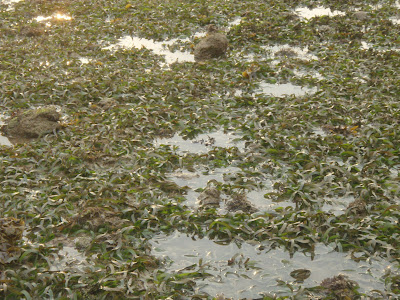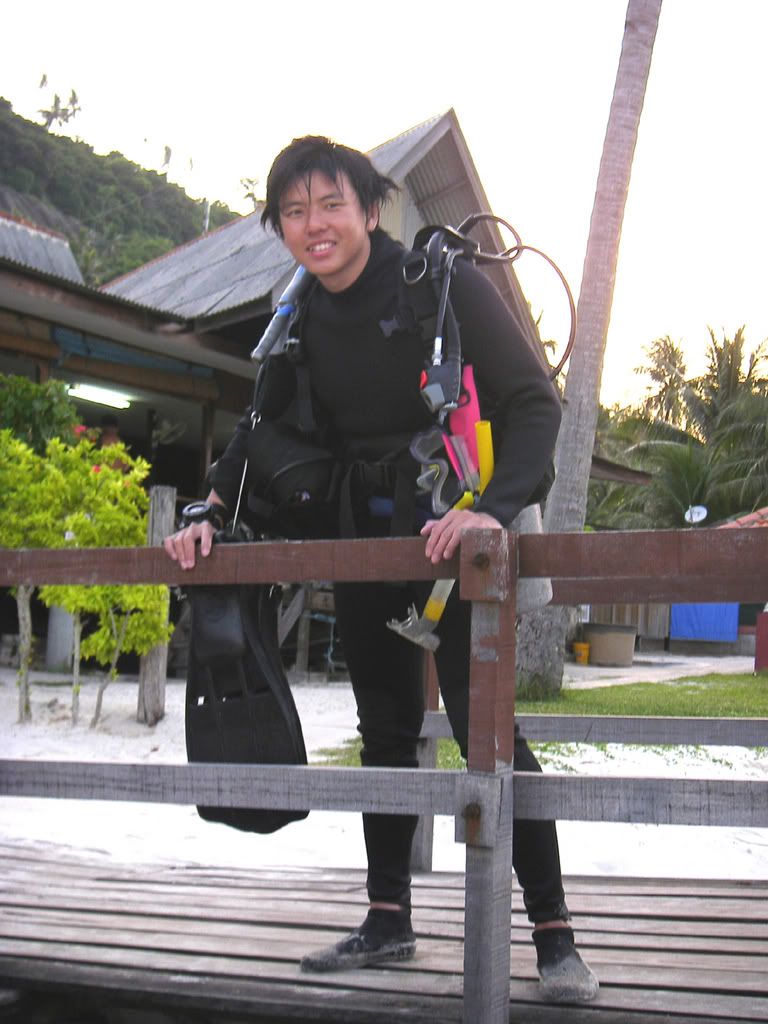Upon reaching the park, there were a few people already busy snapping their cameras. Hmm, I am about to be one of them as well! Never mind about that, I had a quick glance around the area before I entered the 'last rocky shore of Singapore'....
To my sadness, I noticed many artificial structures lying around when the tide recedes. Some of them even looked like the SEACILS which was featured on the newspaper on Oct 29th 2007, which aims to build a underwater garden. This is further confirmed from the article in Straits time today! They look like the same thing! It is really sad that in the attempt to improve the vibrancy of the sub tidal areas, part of our Nature Reserve is concreted. Isn't it amounting to almost 0 net gain ecologically??


Imagine: in future, we may have an Artificial Reserve in place of Nature Reserve in Labrador..
In my opinion, the sub tidal SEACIL, which house the 'relocated' corals may enhance the seashore environment in Labrador Park if it is successful and done in a "Reserve sensitive" way. But now, we may not even have a Labrador rocky shore habitat if it is piled with concrete!

Ok. Enough of Lamentation.. Get on with business... before, next time I may not even have a chance to see any rocky shores on Singapore anymore.. Anyway, I had barely 1hr before the tide rises and the sky turns dark.
As for the remaining of the intertidal zone, the dominant species present there is the sickle sea grass(Thalassia hemprichii), which is the favourite food of Dugongs1. In case you are wondering, yes, Dugongs have been sighted off the shores of Singapore! Also, tape sea grasses (Echalus acoroides), which is the longest sea grass found in Singapore, are seen. Anyway, a group of 3 RGS students have adopted the 'sea grass at Labrador for monitoring'.

 Apart from the sea grasses, the zone also feature other species from the Kingdom Plantae such as the filamentous green algae, Comb seaweeds, Mermaid's Fan and the Red Seaweed. On top of that, at the lower intertidal zone some isolated sponges(phylum porifera) were seen.
Apart from the sea grasses, the zone also feature other species from the Kingdom Plantae such as the filamentous green algae, Comb seaweeds, Mermaid's Fan and the Red Seaweed. On top of that, at the lower intertidal zone some isolated sponges(phylum porifera) were seen.  Together with the sea grasses, the intertidal zone looks like a hidden enchanted garden, which is revealed only when tide recedes.
Together with the sea grasses, the intertidal zone looks like a hidden enchanted garden, which is revealed only when tide recedes. And in this enchanted garden, life is teeming within it! While walking on the exposed seabeds, small fishes, prawns and shrimps could be see swimming in the remaining patches of water left behind and crabs were seen crawling on top of rocks, while molluscs were seen almost motionless under the setting sun.
And in this enchanted garden, life is teeming within it! While walking on the exposed seabeds, small fishes, prawns and shrimps could be see swimming in the remaining patches of water left behind and crabs were seen crawling on top of rocks, while molluscs were seen almost motionless under the setting sun. As this is a rocky shores covered with sargassum, hairy crabs (Pilumnus vespertillio) are abundant here. However, due to their shaggy appearance, which helps them break their natural outline, it is harder for us to spot them. This applies to their predators as well. But on the concrete remains of the SEACILS, which does not provide a proper background for its cryptic colouration, the crab was instantly spotted!
As this is a rocky shores covered with sargassum, hairy crabs (Pilumnus vespertillio) are abundant here. However, due to their shaggy appearance, which helps them break their natural outline, it is harder for us to spot them. This applies to their predators as well. But on the concrete remains of the SEACILS, which does not provide a proper background for its cryptic colouration, the crab was instantly spotted!
Another piece of nature which caught my attention, and even drawn me in for a few minutes was when I saw a pistol shrimp (Alpheus sp.) "doing some construction work from its burrow". It was seen busily moving in and out of its burrow, pushing sediments out everytime it exited. I managed to catch it on a video clip. (the uploaded version is not as clear as the original version, please email me to get the orginal version).
Time literally flew when I was there, with so much to see, yet so little time. Just a blink of the eyes, the sky began to darken, which indicated that its time for me to go back, bringing along a variety of emotions- Satisfied with the sight of nature, sad with the current 'concrete' state of the shore and disappointed with people responsible for such damages.
Keywords/terms:
LLWST: lowest level of the low water spring tides
cryptic colouration: Colours/ marking that help some organism (in this case, hairy crab) hide from predators by blending into their physical surroundings. (Refer to references)
References:
Peter K.L. Ng, Shirley S.L. Lim, Wang Luan-Keng & Leo W.H. Tan. 2007. Private Lives- An Expose of Singapore's Shores. The Raffles Museum of Biodiversity Research. Department of Biological Science. National University of Singapore.
Dr Leo WH Tan, Peter KL Ng. 1992. A guide to seashore life. Singapore Science Centre.
Solomon, Berg, Martin. (2007) Biology, 8th Edition. Thomson Brooks/Cole.
(for the definition of cryptic colouration)
Related Links/Blogs:
After posting this entry, I have been told by some of my friends that this entry is linked by some related entries on Labrador as follows:
Updates on large concrete slabs on Labrador shore
http://wherediscoverybegins.blogspot.com/2007/11/discovery-labrador-mangroves-on-25-nov.html


1 comment:
Very nice.Reports are rich informations.
Post a Comment